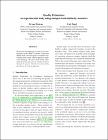Browsing Computer Science by Title
Now showing items 1475-1494 of 2087
-
Q. Can Knowledge Graphs be used to Answer Boolean Questions? A. It's complicated!
(Association for Computational Linguistics, 2020)In this paper we explore the problem of machine reading comprehension, focusing on the BoolQ dataset of Yes/No questions. We carryout an error analysis of a BERT-based machine reading comprehension model on this ... -
Qos-aware error recovery in wireless body sensor networks using adaptive network coding
(2015)Wireless body sensor networks (WBSNs) for healthcare and medical applications are real-time and life-critical infrastructures, which require a strict guarantee of quality of service (QoS), in terms of latency, error rate ... -
Quality Assessment for Omnidirectional Video: A Spatio-Temporal Distortion Modeling Approach
(2020)Omnidirectional video, also known as 360-degree video, has become increasingly popular nowadays due to its ability to provide immersive and interactive visual experiences. However, the ultra high resolution and the spherical ... -
Quality Estimation: an experimental study using unsupervised similarity measures
(The Association for Computational Linguistics (ACL), 2012)We present the approach we took for our participation to the WMT12 Quality Estimation Shared Task: our main goal is to achieve reasonably good results without appeal to supervised learning. We have used various similarity ... -
Quality Improvement in the Mapping Process required for Linked Data publication
(Trinity College Dublin. School of Computer Science & Statistics. Discipline of Computer Science, 2023)This thesis presents a quality improvement approach named the Mapping Quality Improvement (MQI) Framework designed to improve and maintain quality in the publication process involved in the creation of linked data. Linked ... -
Quality Queue Management for Future Wireless Networks
(Trinity College DublinTrinity College Dublin. School of Computer Science & Statistics. Computer Science, 2017)Wireless networking protocols and mobile devices are key contributors to the ever-growing demand for realtime services. These large throughput services are often prioritised and managed using specialised traffic policies. ... -
Quantification of Mutual Understanding in Task-Based Human-Human Interactions
(Trinity College Dublin. School of Computer Science & Statistics. Discipline of Computer Science, 2021)This thesis explores the quantification of mutual understanding in task-based interactions by observing the relation between patterns of repetitions and measures of communicative success. Two important characteristics of ... -
Quantifying dominance in the Multisimo corpus
(2018)This paper is concerned with investigating conversational (verbal and non verbal) features related to conversational dominance and discovering evident relations between these features, personality traits and perceived ... -
Quartz: A QoS Architecture for Open Systems
(University of Dublin, Trinity College. Department of Computer Science, 1999-12)The term `QoS architecture? is used to describe middleware that provides applications with mechanisms for specification and enforcement of quality of service (QoS) requirements. These architectures administer the resources ... -
Quartz: a QoS architecture for open systems
(IEEE, 2000)This paper describes an architecture that provides support for quality of service (QoS) specification and enforcement in heterogeneous distributed computing systems. The Quartz QoS architecture has been designed to ... -
Quartz: Supporting QoS-constrained services in heterogeneous environments
(IEEE, 1998)This paper describes an architecture that addresses common problems found in systems supporting QoS specification and enforcement, such as lack of flexibility and expressiveness in the specification of requirements and ... -
Queryable Provenance Metadata For GDPR Compliance
(2018)Information associated with regulatory compliance is often siloed as legal documentation that is not suitable for querying or reuse. Utilising open standards and technologies to represent and query this information can ... -
Rabbit Run: Gaze and Voice Based Game Interaction
(2009)Modern eye tracking technology allows an observer?s gaze to be determined in realtime by measuring their eye movements. Recent studies have examined the viability of using gaze data as a means of controlling computer games. ... -
Random Numbers
(Sage Publications, 2006) -
Random subspacing for regression ensembles
(Trinity College Dublin, Department of Computer Science, 2004)In this work we present a novel approach to ensemble learning for regression models, by combining the ensemble generation technique of random subspace method with the ensemble integration methods of Stacked Regression ... -
Re-using Implicit Knowledge in Short-term Information Profiles for Context-sensitive Tasks
(Trinity College Dublin, Department of Computer Science, 2005-02-22)Typically, case-based recommender systems recommend single items to the on-line customer. In this paper we introduce the idea of recommending a user-defined collection of items where the user has implicitly encoded ... -
REACT: REal-time Adaptive Collision Testing, a Interactive Vision approach
(1997)As the demand for high levels of interaction in computer systems increases, so too does the need for real-time, interactive animation. Detecting collisions between geometrically modelled objects remains a major bottleneck in ... -
A Reaction Diffusion Model for Wireless Indoor Propagation
(Trinity College Dublin. Department of Computer Science, 2002-09)The biological pattern formation system known as the reaction-diffusion mechanism is used as a base for a simulator which will predict the propagation of RF signals in an indoor environment. The reaction diffusion system ...






















